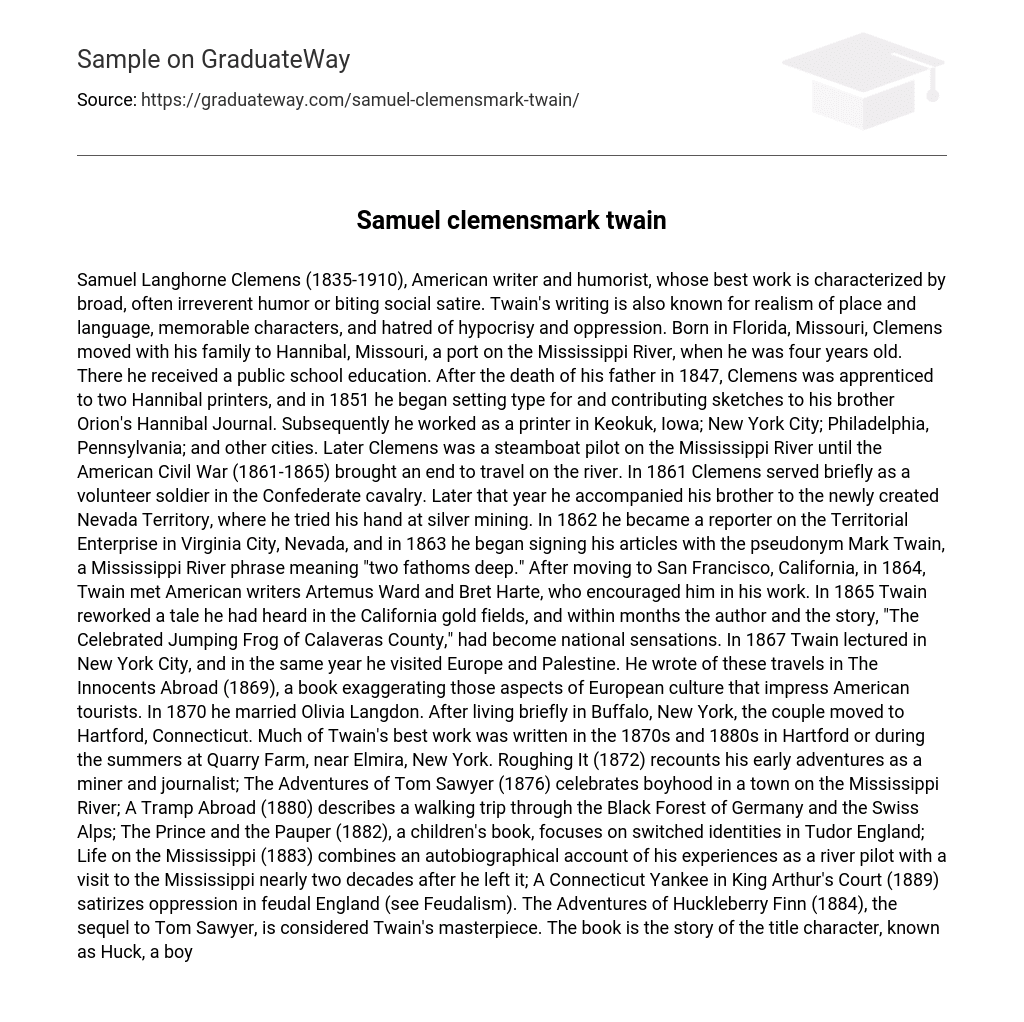Samuel Langhorne Clemens (1835-1910), an American writer and humorist, gained fame for his comedy, sharp social satire, authentic portrayal of place and language, memorable characters, and his disdain for hypocrisy and oppression. He was born in Florida, Missouri but moved to Hannibal at the age of four with his family. He received education in public schools there. After his father passed away in 1847, Clemens became an apprentice to two printers in Hannibal. In 1851, he started typesetting and contributing sketches to his brother Orion’s Hannibal Journal. Later on, he worked as a printer in Keokuk, Iowa; New York City; Philadelphia, Pennsylvania; as well as other cities.
During the American Civil War (1861-1865), Clemens served as a steamboat pilot on the Mississippi River until river travel ceased. In 1861, he briefly volunteered as a soldier in the Confederate cavalry before joining his brother in Nevada Territory where they tried their hand at silver mining. By 1862, Clemens found employment as a reporter for the Territorial Enterprise in Virginia City under the pen name Mark Twain which refers to “two fathoms deep” according to Mississippi River jargon.
After moving to San Francisco in 1864, Clemens met fellow American writers Artemus Ward and Bret Harte who encouraged him to pursue writing.In 1865, Mark Twain took a tale from California’s gold fields and revised it into “The Celebrated Jumping Frog of Calaveras County,” which gained national attention. In 1867, Twain gave a lecture in New York City before embarking on a trip to Europe and Palestine. He documented his travels in The Innocents Abroad (1869), exaggerating aspects of European culture that impressed American tourists. In 1870, Twain married Olivia Langdon and they settled initially in Buffalo, New York before moving to Hartford, Connecticut.
During the 1870s and 1880s, Twain produced much of his notable work while living in Hartford or spending summers at Quarry Farm near Elmira, New York. Notable works from this period include Roughing It (1872), The Adventures of Tom Sawyer (1876), A Tramp Abroad (1880), The Prince and the Pauper (1882), Life on the Mississippi (1883), A Connecticut Yankee in King Arthur’s Court (1889). However, it was Twain’s renowned masterpiece, The Adventures of Huckleberry Finn(1884) that is widely considered as a sequel to Tom Sawyer focusing on Huck,the main character who escapes his father by rafting down the Mississippi River with Jim,a runaway slave. Through their adventures, both Huck and the reader witness the harsh realities of humanity.The novel’s theme centers around Huck’s internal conflict between his friendship with Jim, whom he can truly rely on, and his understanding that aiding Jim in his escape goes against societal norms. Huckleberry Finn stands out for its authentic language and unwavering commitment to freedom, as it is mostly portrayed from Huck’s point of view. Moreover, Huck’s adventures offer a comprehensive portrayal of life in America along the Mississippi before the Civil War. Twain’s talent in capturing the unique rhythms of this time period helps solidify this book as an esteemed literary masterpiece in America.
Founded by Mark Twain in 1884, Charles L. Webster and Company aimed to publish both his own writings and works from other authors. One notable publication during this time was Personal Memoirs, a two-volume book authored by Ulysses S. Grant, an American general and president. These volumes were released between 1885 and 1886.
The company’s financial downfall occurred when they invested in an unsuccessful automated typesetting machine, leading to bankruptcy in 1894. Despite this setback, Twain managed to recover through a successful worldwide lecture tour.
In order to further aid his financial recovery, Twain published Following the Equator in 1897. This book chronicled his experiences during his travels and helped him repay his debts.
During the 1890s and 1900s, Mark Twain’s literary works became more pessimistic and bitter. These emotions were influenced by his business failures as well as the tragic deaths of his wife and two daughters. Notable pieces from this time include Pudd’nhead Wilson (1894), a novel that critiques racism in the pre-Civil War South by highlighting mistaken racial identities. Another important work is Personal Recollections of Joan of Arc (1896), which serves as a sentimental biography. Additionally, Twain wrote short stories like “The Man That Corrupted Hadleyburg” (1899) and “The War Prayer” (1905), along with essays on philosophy, society, and politics. His unfinished manuscript, “The Mysterious Stranger,” was published after his death in 1916. He also documented his own life through autobiographical dictations.
Twain drew inspiration from the unconventional West, diverging from the dominance of New England writers in American literature. While initially praised for his humor, later generations recognized Twain’s significant contribution to genuine American literature development. Through his use of humorous yet poetic language, Mark Twain helped break America’s fascination with British and European culture and its formal language conventions.
Mark Twain’s focus on American themes, settings, and language set him apart from other writers of his time and greatly influenced future American authors such as Ernest Hemingway and William Faulkner.Twain, known for his writing, also gained fame as a public figure. In his later years, he spoke out on various issues and was easily recognizable by his signature white linen suit worn during public appearances. In 1907, Oxford University awarded him an honorary doctorate. Following his death, Twain’s secretary Albert Bigelow Paine edited and published his unfinished autobiography in 1924. A significant discovery occurred in 1990 when the first half of Huckleberry Finn’s handwritten manuscript was found in Hollywood, California. After resolving legal disputes, the previously unpublished material was reunited with the second half at the Buffalo and Erie County (New York) Public Library in 1992. Finally, a revised edition of Huckleberry Finn incorporating this unpublished material was released in 1996.
Here is the bibliography:





